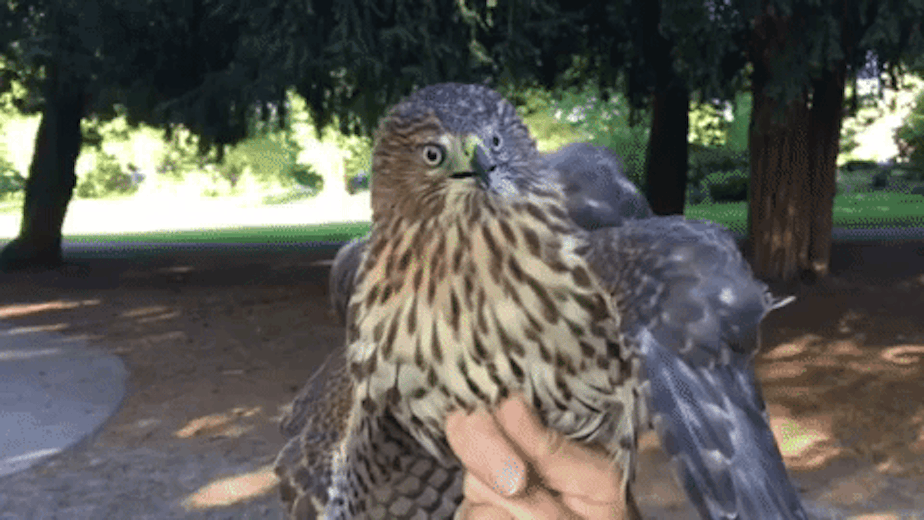What's that screeching? Maybe a hungry young Cooper's Hawk
 1 of 5Martin Muller holds a juvenile female Cooper's Hawk. The Urban Raptor Conservancy is aiming to catch and tag the roughly 200 young Cooper's Hawks now nesting in Seattle.
1 of 5Martin Muller holds a juvenile female Cooper's Hawk. The Urban Raptor Conservancy is aiming to catch and tag the roughly 200 young Cooper's Hawks now nesting in Seattle. Have you noticed lately a lot of high-pitched screeching in your neighborhood? Well, it could be a family of Cooper’s Hawks.
Volunteer researchers say there are 44 active Cooper’s Hawks nests in the city of Seattle right now, and the nesting pairs are raising more than 200 young.
Young Cooper's Hawks have been making a racket in my neighborhood. And what are they saying when they screech?
"I’m here. I’m hungry. Feed me," said Martin Muller from the Urban Raptor Conservancy.
"They are food begging. They they want their parents to know where they are so the next meal comes to them."
I ran into Muller one morning in my neighborhood park. He told me a pair of Cooper’s Hawks is nesting in a tall tree there along with their five young.
He was holding one of the birds he had trapped, a 7-week-old female.
"We know it’s a female because she’s big. Males are smaller than females," he said.
Muller had trapped the hawk and slipped her inside a tube made from aluminum cans. As the hawk sat quietly, Muller prepared to put two bands on her legs — on her left foot, a silver U.S. Fish and Wildlife Service band, and on her right foot, an orange band for the study now being undertaken by the Urban Raptor Conservancy.
He took careful measurements of her legs. "We want the band to spin around freely so it doesn’t damage her leg, but we don’t want it to slide over her foot so she can’t hunt," he said. The hawks hunt with their feet.

The Urban Raptor Conservancy has been monitoring Cooper’s Hawks in the city since 2003. Back then, volunteers only located three nests.
The hawks' population has exploded since then, in part because the city provides an ample selection of their favorite prey: songbirds and small rodents. Also as the city’s tree canopy matures, it’s giving them more places to nest.
The conservancy is hoping that people contact them when they spot the adult birds. A lot have shown up on Whidbey Island. One was spotted as far away as California.
Muller said many Seattle residents are unaware that these amazing birds are living right in their midst.
"It's a critter that has to be an Olympic athlete every day to be able to survive," Muller said. "And you watch them and it's just great fun."
A few fun facts about Cooper's Hawks:
- The male hunts for the entire family. He has to bring home the equivalent of one songbird an hour for the family to survive.
- Females hang around and help the young hawks as they learn to hunt. You might say they are helicopter parents -- they perch in nearby trees to keep an eye on their young. That's why when the birds nest, they look for places that have a cluster of trees.
- They hunt by grabbing birds out of trees and shrubs. So if you see a Cooper's Hawk sitting on the ground, leave them alone -- they might actually be on the lookout for food.










